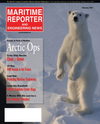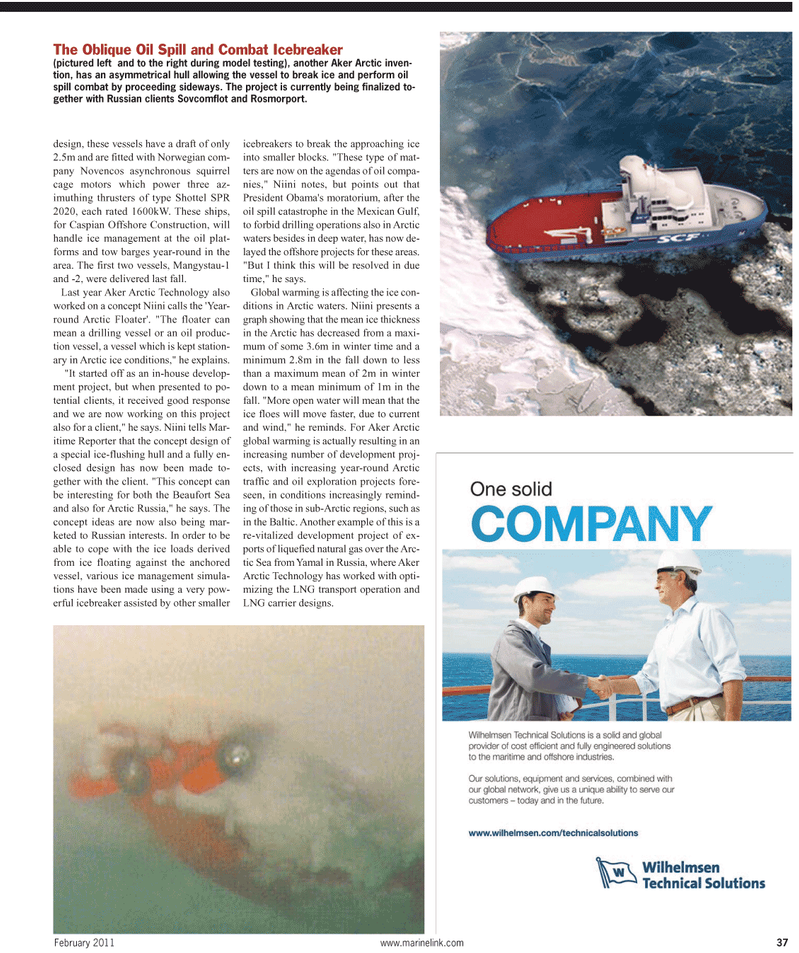
Page 37: of Maritime Reporter Magazine (February 2011)
Cruise & Passenger Vessel Annual
Read this page in Pdf, Flash or Html5 edition of February 2011 Maritime Reporter Magazine
The Oblique Oil Spill and Combat Icebreaker (pictured left and to the right during model testing), another Aker Arctic inven- tion, has an asymmetrical hull allowing the vessel to break ice and perform oil spill combat by proceeding sideways. The project is currently being finalized to- gether with Russian clients Sovcomflot and Rosmorport. design, these vessels have a draft of only 2.5m and are fitted with Norwegian com- pany Novencos asynchronous squirrel cage motors which power three az- imuthing thrusters of type Shottel SPR 2020, each rated 1600kW. These ships, for Caspian Offshore Construction, will handle ice management at the oil plat- forms and tow barges year-round in the area. The first two vessels, Mangystau-1 and -2, were delivered last fall.
Last year Aker Arctic Technology also worked on a concept Niini calls the 'Year- round Arctic Floater'. "The floater can mean a drilling vessel or an oil produc- tion vessel, a vessel which is kept station- ary in Arctic ice conditions," he explains. "It started off as an in-house develop- ment project, but when presented to po- tential clients, it received good response and we are now working on this project also for a client," he says. Niini tells Mar- itime Reporter that the concept design of a special ice-flushing hull and a fully en- closed design has now been made to- gether with the client. "This concept can be interesting for both the Beaufort Sea and also for Arctic Russia," he says. The concept ideas are now also being mar- keted to Russian interests. In order to be able to cope with the ice loads derived from ice floating against the anchored vessel, various ice management simula- tions have been made using a very pow- erful icebreaker assisted by other smaller icebreakers to break the approaching ice into smaller blocks. "These type of mat- ters are now on the agendas of oil compa- nies," Niini notes, but points out that
President Obama's moratorium, after the oil spill catastrophe in the Mexican Gulf, to forbid drilling operations also in Arctic waters besides in deep water, has now de- layed the offshore projects for these areas. "But I think this will be resolved in due time," he says.
Global warming is affecting the ice con- ditions in Arctic waters. Niini presents a graph showing that the mean ice thickness in the Arctic has decreased from a maxi- mum of some 3.6m in winter time and a minimum 2.8m in the fall down to less than a maximum mean of 2m in winter down to a mean minimum of 1m in the fall. "More open water will mean that the ice floes will move faster, due to current and wind," he reminds. For Aker Arctic global warming is actually resulting in an increasing number of development proj- ects, with increasing year-round Arctic traffic and oil exploration projects fore- seen, in conditions increasingly remind- ing of those in sub-Arctic regions, such as in the Baltic. Another example of this is a re-vitalized development project of ex- ports of liquefied natural gas over the Arc- tic Sea from Yamal in Russia, where Aker
Arctic Technology has worked with opti- mizing the LNG transport operation and
LNG carrier designs.
February 2011 www.marinelink.com 37

 36
36

 38
38
